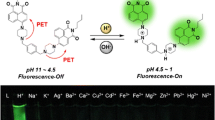Abstract
Increasing acidity is an effective method for bacterial inactivation by inhibiting the synthesis of intracellular proteins at low pH. Photo-driven proton release probe can be used for the measurement of proton in hydrophobic condition. To develop fluorescent proton donor, two boron dipyrromethene derivatives (BDP-S and BDP-S2) were characterized by spectroscopic methods. Irradiation of BDP-S by white LED light resulted in efficient generation of acidic species with changes of fluorescence emission. The linear relationship between the pH value and the fluorescence intensity of BDP-S was obtained, indicating that BDP-S is a fluorescent visual proton donor. Light-induced antibacterial results indicate that BDP-S can significantly inhibit the growth of E. coli. The results prove that BDP-S is a very promising photoacid sterilant.







Similar content being viewed by others
Data Availability
The data used to support the findings of this study are included within the article.
References
Stuart B, Bonnie M (2004) Antibacterial resistance worldwide: causes, challenges and responses. Nat Med 10:122–129
Kieron O, James H, Hannah S, Martin W, George S, David S (2013) Combating multidrug-resistant bacterial: current strategies for the discovery of novel antibacterials. Angew Chem Int Ed 52:10706–10733
Kim CB, Yi DK, Seung P, Soo K, Lee W, Kim MJ (2009) Rapid photothermal lysis of the pathogenic bacteria, Escherichia coli using synthesis of gold nanorods. J Nansci Nanotechnol 9:2841–2845
Lu JY, Zhang PL, Chen QY (2019) A nano-BODIPY encapsulated zeolitic imidazolate framework as photoresponsive integrating antibacterial agent. ACS Appl Bio Mater 3:458–465
Luo Y, Wang C, Peng P, Hossain M, Jiang T, Fu Wl, Liao Y, Su M (2013) Visible light mediated killing of multidrug-resistant bacteria using photoacids. J Mater Chem B 1:997–1001
Amdursky N, Simkovitch R, Huppert D (2014) Excited-state proton transfer of photoacids adsorbed on biomaterials. J Phys Chem B 118:13859–13869
Haghighat S, Ostresh S, Dawlaty J (2016) Controlling proton conductivity with light: a scheme based on photoacid doping of materials. J Phys Chem B 120:1002–1007
Escuín R, Luisa M, Vaca G, Carbonell J,LuisJ, Pedro AS (1983) A study of the photochemical response of o-nitrobenzyl cholate derivatives in P(MMA‐MAA) matrices. J Poly Sci : Poly Chem Ed 21:1075–1083
Tsuguo Y, Hirosh A, Kazuo M, Hiroo W, Tsutomu S (1990) Photochemical dissociation of p-nitrobenzyl 9,10-dimethoxyanthracene-2- sulphonate via intramolecular electron transfer. J Chem Soc Perkin Trans II 2:1709–1714
Arnold A, Fratesi E, Bejan E, Cameron J, Pohlers G, Liu H, Scaiano J (2004) Evidence of homolytic and heterolytic pathways in the photodissociation of iminosulfonates and direct detection of the p-toluenesulfonyloxyl radical. Photochem Photobiol Sci 3:864–869
Ditkovich J, Mukra T, Pines D, Huppert D, Pines E (2015) Bifunctional photoacids: remote protonation affecting chemical reactivity. J Phys Chem B 119:2690–2701
Andraos J, Barclay G, Medeiros D, Baldovi M, Scaiano J, Sinta R (1998) Model studies on the photochemistry of phenolic sulfonate photoacid generators. Chem Mater 10:1694–1699
Martina C, Rapenneab G, Nakashimac T, Kawai T (2018) Recent progress in development of photoacid generators. J Photochem Photobiol C: Photochem Rev 34:41–51
Shi Z, Peng P, Strohecker D, Liao Y (2011) Long-lived photoacid based upon a photochromic reaction. J Am Chem Soc 133:14699–14703
Fu C, Xu J, Boyer C (2016) Photoacid-mediated ring opening polymerization driven by visible light. Chem Comm 52:7126–7129
Huang DL, Fang XL, Chen QY, Gao J (2018) Polymer united Fe3O2 nanospheroids for water oxidation and the green synthesis of 2,3-dihydrophathazine-1,4-dione. ACS Sustain Chem Eng 6:11280–11285
Xia Y, Peng L (2013) Photoactivatable lipid probes for studying biomembranes by photoaffinity labeling. Chem Rev 11:37880–37929
Xu J, Shen X, Jia L, Zhang C, Zhou T, Zhu T, Xu Z, Cao J (2018) A ratiometric nanosensor based on lanthanide-functionalized attapulgite nanoparticle for rapid and sensitive detection of bacterial. Dye Pigment 148:44–51
Zhu X, Zhu Z (2018) The generalized predictive control of bacteria concentration in marine lysozyme fermentation process. Food Sci Nutr 7:1387–1395
Shao J, Chen QY, Zheng QL (2020) Nano adamantane-conjugated BODIPY for lipase affinity and light driven antibacterial. Spectrochim Acta A 234:118252–118255
Zhang PL, Shao J, Chen QY, Qu LL (2019) A protein amantadine-BODIPY assembly as a turn-on sensor for free copper(II). Analy Methods 11:827–831
Saravanan V, Rajakumar P (2018) Synthesis, characterization, optical and electrochemical properties and antibacterial activity of novel BODIPY glycoconjugated dendrimers. New J Chem 42:2504–2512
Li Z, Zhu Z, Sun Z, Ding J, You J (2019) Design of a multifunctional biotinylated copper complex for visualization and quantification of cancer hypoxia levels. Sens Actuators B Chem 282:541–548
Zhang PL, Chen QY, Du X, Gao J (2019) Biocompatible-G-quadruplex/BODIPY assembly for cancer cell imaging and the attenuation of mitochondria. Bioorg Med Chem Lett 29:1943–1947
Fu YJ, Li Z, Li CY, Li YF, Wen LH (2017) Borondipyrrolemethene-based fluorescent probe for distinguishing cysteine from biological thiols and its application in cell image. Dyes Pigments 139:381–387
Pohlers G, Scaiano J, Sinta R (1997) A novel photometric method for the determination of photoacid generation efficiencies using benzothiazole and xanthene dyes as acid sensors. Chem Mater 9:3222–3230
Acknowledgements
This work was financially supported by the National Natural Science Foundation of China (21701056).
Funding
This work was financially supported by the National Natural Science Foundation of China (21,701,056).
Author information
Authors and Affiliations
Contributions
All authors contributed to the study conception and design. Conceptualization: Qiu-Yun Chen; Methodology: Ling-Ling Qu; Formal analysis and investigation: Abbas Mohammed Ali, Jian Shao, Jia-Xin Wang and Yang Li; Writing- original draft preparation: Abbas Mohammed Ali; Writing - review and editing: Qiu-Yun Chen and Ling-Ling Qu; Funding acquisition: Ling-Ling Qu; Supervision: Qiu-Yun Chen.
Corresponding authors
Ethics declarations
Conflict of Interest
The authors declare that there is no conflict of interest.
Additional information
Publisher’s Note
Springer Nature remains neutral with regard to jurisdictional claims in published maps and institutional affiliations.
Supplementary Information
ESM 1
(DOC 2273 kb)
Rights and permissions
About this article
Cite this article
Ali, A.M., Shao, J., Wang, JX. et al. A Fluorescent Visual Proton Donor and Photoacid Sterilant Based on Sulfonate‐conjugated BODIPY. J Fluoresc 31, 501–507 (2021). https://doi.org/10.1007/s10895-021-02682-8
Received:
Accepted:
Published:
Issue Date:
DOI: https://doi.org/10.1007/s10895-021-02682-8




